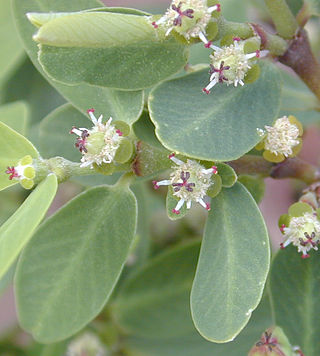Top Qs
Timeline
Chat
Perspective
Euphorbia celastroides
Species of plant in the family Euphorbiaceae From Wikipedia, the free encyclopedia
Remove ads
Euphorbia celastroides is a flowering plant in the family Euphorbiaceae.[1] It is referred to by the common name 'akoko by Hawaiians, and is a species of spurge closely related to the poinsettia.[2] This species develops into a round-shape shrub. This species is endemic to the Hawaiian Islands.
Remove ads
Description

Euphorbia celastroides grows as a medium-sized shrub or small tree reaching 2 metres (6.6 ft) in height.[3] To grow properly, this species requires temperatures of 15 °C (59 °F) and light shade.[4] This plant develops in a fashion similar to a shrub. In the summer, it assumes a red-violet colouring. It does not lose its leaves in the winter, due to the warm climate of its range. Female flowers have a three-part pistil over a three-part ovary, usually producing three (or sometimes more) seeds.[4] This species is tolerant of heat and drought. They are susceptible to fungal diseases. Its cyathia may be located in short or open-branched cymes, or remain ungrouped in leaf axils. The leaves are distichous (grow in two vertical rows) and may have a glaucous coating. This plant produces a green or brown, rounded fruit 2 to 4 mm long, containing grey-brown seeds 0.5 to 2.5 mm long.[3]
Remove ads
Distribution and habitat
Most varieties of this species can only be found in the Hawaiian Islands.[5][6] E. celastroides is tolerant of drought and grows in dry areas, inland as well coastal.[7] This species is endemic to the polihale and kanaio regions of Kauai and Maui.[8]
Conservation
Euphorbia celastroides has not yet been evaluated by the IUCN.[9] However, due to its endemic nature, it is very vulnerable to human threats. Two examples of such threats are four-wheeled vehicles (which crush the plant) and introduced species (which compete for resources).[8]
Varieties

This plant has many varieties. These varieties include:[10]
- Var. amplectens
- Var. halawana
- Var. hanapepensis
- Var. haupuana
- Var. humbertii
- Var. ingrata
- Var. kaenana
- Var. kohalana
- Var. laehiensis
- Var. lorifolia
- Var. mauiensis
- Var. nelsonii
- Var. nematopoda
- Var. niuensis
- Var. pseudoniuensis
- Var. saxicola
- Var. typica
- Var. waikoluensis
References
Wikiwand - on
Seamless Wikipedia browsing. On steroids.
Remove ads

